See also: “Our World” – more about this programme
David Taylor
I’m trying to produce an article about the ‘TV side’ of the most notable ‘Beatles BBC TV ‘ segment, when “All You Need Is Love” was shown to The World (as part of “Our World”), I thought I’d ask something about the photo of the “Our World” crew in TC1 that was shown in a 2016 post here on Tech Ops.First off, I’m an ex-LWT Sound Supervisor, so I don’t know any of the people who would have been at either the TC1 /TC2 end or the Beatles EMI Abbey Road studio 1 OB. However…I know a man who does……
Thanks to both Brian Summers and Nick Gilbey, I’ve been put in touch with Sandy Tristem, who was a cameraman on the crew of the OB at Abbey Road. He’s worked out the other members of his crew etc…and we know it was MCR28, with Derek Burrell-Davis directing. It looks like Hugh Cartwright was the EM lighting it and they had a Mole crane with Dave Gautier on the camera.
As I’m sorting out the OB end I can move on to the TC1/TC2 studio. Thanks to the posts on Tech Ops that started in Nov 2014 and continued with Alec Bray’s of 2016…I have the photo below…plus your comments on the guys seen.
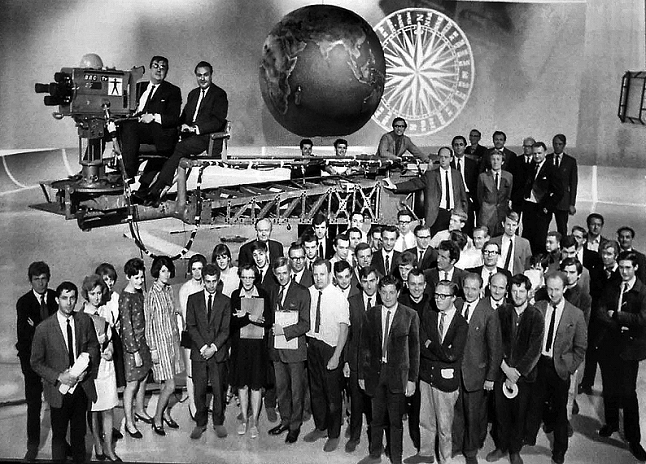
[Ed: For a comprehensive, minute by minute description of the planning, rehearsal and transmission of “Our World” please see David Taylor’s full account HERE .]
Tony Grant
I worked on “Our World”, but next door in TC2, simply adding in the odd caption throughout the proceedings. I’m fairly sure that was when I was in crew 15, Ian Gibb (Emu), although not all of us are in the ‘official’ photo here (yes, I missed out).As far as the photo goes, I can see Mother (Joan Marsden) was FM, clutching a clip board, front row centre,
I also spot various crew members, such as Doug Puddifoot, clutching a roll of camera tape, John Corby, I think, just behind him, and John Farr behind him again. There’s Mike Minchen a few along from Mother, and lot’s of familiar faces to whom I am as yet unable to put names to.
Dave Newbitt.
Is that Dave Hanks just behind Mother?Dave Mundy
Certainly looks like him,Geoff Hawkes
First off, the crane …in the picture is… a Transatlantic. I worked on “The Songs of the American Civil War” in TC1 where it was used and it came with its own driver.I recognise a few of the people pictured, notably FM “Mother” Joan Marsden in the front row with arms across her script board and what may be cameraman Mike Figini two places to the right of her wearing a characteristic white shirt with the sleeves rolled up. The man behind Joan’s camera left shoulder I’m pretty sure is Vision Mixer Dave Hanks as Dave says as he has that look about him.
At the back right, the man highest up leaning over the arm of the crane could be Terry Loader and in the middle of the group on the right, the man in the glasses with head tilted up looks like lighting man John Farr but he can confirm or deny that I’m sure. The bald guy in front of him looks like a back projection operator whose name I’ve forgotten (was it Ted?).
Other people will no doubt give their opinion on all of this but it would be a good day if everyone in the picture was identified positively as the faces are a bit blurred anyway. The task would be made easier if someone could overlay a numbering plan on it so we knew which of the people we were talking about,
Roger Bunce
Agreed about Joan Marsden (‘Mother’), Dave Hanks and Mike Figini.Going diagonally up/right from Mike’s shoulder, the third face looks like Mike Langley Evans. A few faces further right, and up a bit, the background character (head turned sideways and up) could be Dave Austwick. I find myself worrying that the chap foreground, far left, holding a script looks like Nigel Saunders, but wouldn’t he have been a lot younger then?
Dave Newbitt.
Agree with Roger about Mike Langley Evans. As ever with these challenges it always seems gradually to come together.Dave Beer
I agree about most of those names. I’m in there somewhere as I remember working on the programme but can’t recognise my junior self. I remember lots of hanging about with not much happening as with these big international shows. Far right, second row up, 2 in from the right looks like Mitch Mitchell in dark jacket, dark shirt and dark hair.Bernie Newnham
Ok, here’s a numbered version:
8 Jim Stevens
18 Al Kerridge (maybe)
31 Doug Watson
40 Mitch
50 Darrol Blake
53 Norman Taylor
54 Bob Wright
Did they take TC2 cameras into TC1?
Pity no one has a better quality version, though it must exist
Nick Ware
I don’t think I’ve ever seen so many ties all in the same place at the same time! How times have changed.Identifying people isn’t helped by the fact that to my eye the picture is horizontally challenged (squeezed).#
Dave Beer
I’m possibly No 42. It looks like my ear!Bernie Newnham
I thought that you were 35.Dave Newbitt.
Here’s a stab at a couple more :38 Graham Beebee
39 Greg Ade
Sometimes a name just flits across the memory and one hopes it’s based on something! One thing I remember when Beebee’s first born arrived was his response to enquiries about how he was doing for sleep. Being a good musical man he replied “we have bambino con sordino”!
Pat Heigham
I think number 2 might be John Lopes. He moved into production, so looks likely.He came to my 21st, some [many] years ago, and made quite a hit with a female cousin of mine!
Mike Giles
Is number 31 Martin Kisner?Roger Bunce
Could number 36 be Ian Gibb?Geoff Hawkes
Well done, Bernie, for adding the numbering as it makes the discussion so much easier.John Farr could be the one in the back row at number 48 rather than at 38 as that row seems to be a line-up of lighting people along with gaffer Bob Wright.
No.52 is another lighting man or TM (or TOM, when did it change?), Frank Cresswell comes to mind, but I don’t think it’s him. This exercise is going to lead to much frustration for those of us with fading memories. Weren’t we supposed to be good at recalling ancient memories even when we’d forgotten our way home? As one person remarked previously, after a while our memories become read-only, to which I replied that they then become write only.
Someone mentioned about the camera and whether TC2’s cameras were used. I think it must have come from 2 as TC1 had EMIs and that is a Marconi. When I joined in September 1963 there were only four studios in operation and apart from Pres A [and Pres B] which had EMI Vidicons, TC2 and TC3 used Marconis and TC4 and TC5 used EMIs as the BBC couldn’t be seen to favour one manufacturer over the other.
TC1 opened in 1964 with EMIs and TC7 at about the same time, though I can’t remember which cameras 7 had, Marconi s to even it out, I would guess. I think TC6 and TC 8 weren’t opened till colour came along. TVT by the time I worked there had Pyes with electronic lens changes, as did R1 and R2, I think. Dudley Darby will give the details and correct me if I’m wrong.
Tony Grant
TC2 cameras stayed in TC2 mostly for captions/graphics.Bill Jenkin
I was working on this show but for some reason I am not in the photo and I beg to differ, Tony. The way I remember it is that TC2’s cameras were in TC1. If you look at the photo the camera is a Marconi Mk IV so not one of TC1’s complement.Peter Fox
I agree with Bill. I recall working with him on it and using a couple of TC2 cameras.
We were a little bit concerned about being on a different phase from TC1 cameras and that we might vanish in a puff of self cancelling positrons and electrons if we touched (joking!) We were however kept apart by being on an overlooking rostrum.
Tony Grant
OK, I can’t argue with anyone who was in TC1, as I was definitely in TC2 behind a camera (with captions!). So, perhaps that’s why I didn’t make the photo as only those who were in TC1 knew about it (and they missed my best side).Barry Bonner
TC7 Cameras? Herewith Steve Blatchford working one not long after the studio opened.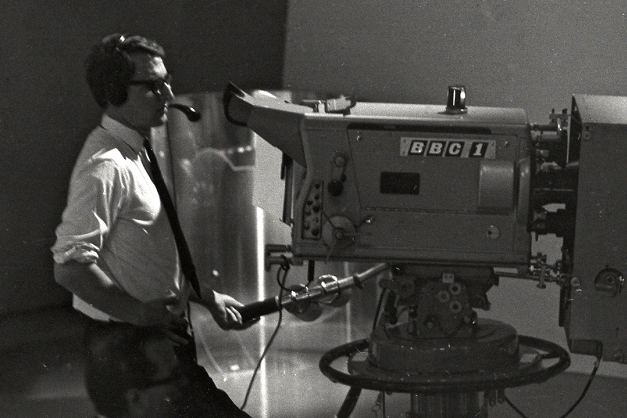
Bill Jenkin
I also have a memory of Geoff Nichols working on this but can’t spot him.I do remember Joan Marsden, when asked to say something to test circuits, coming out with, “This is mother calling the World”.
Pat Heigham
Joan was quite fierce but ran the studio with impeccable discipline.- see Mother
Mike Jordan
I don’t know if it is still there but there was a large exhibition back in 2015 in the Science Museum all about “Tomorrow’s World”.Just a few of my pics of the display.
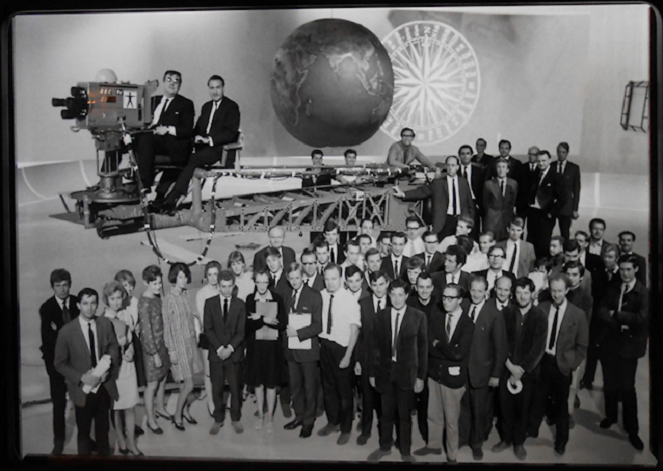
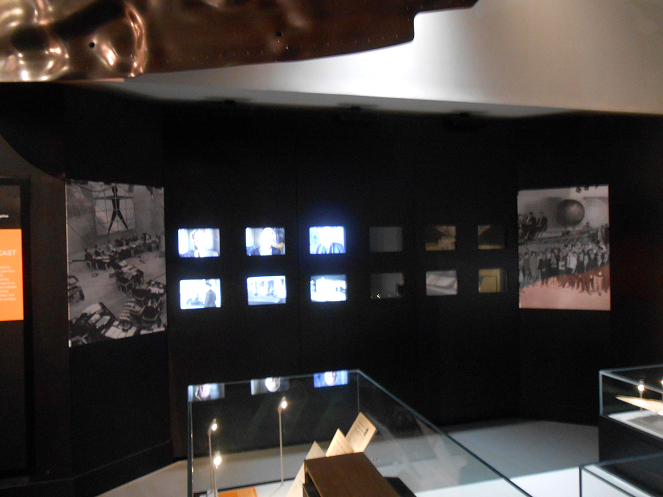
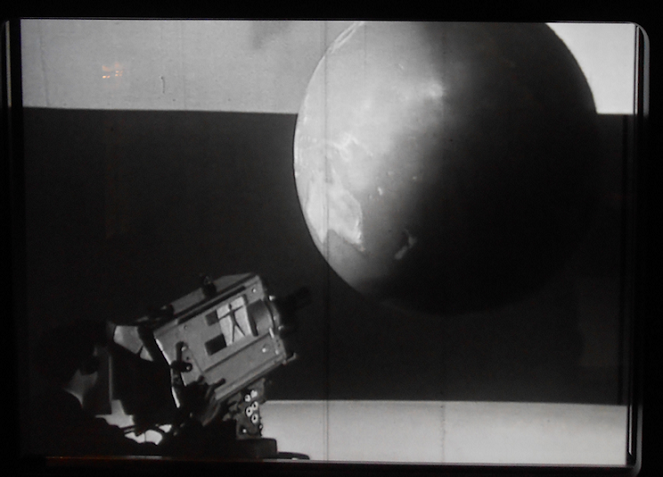
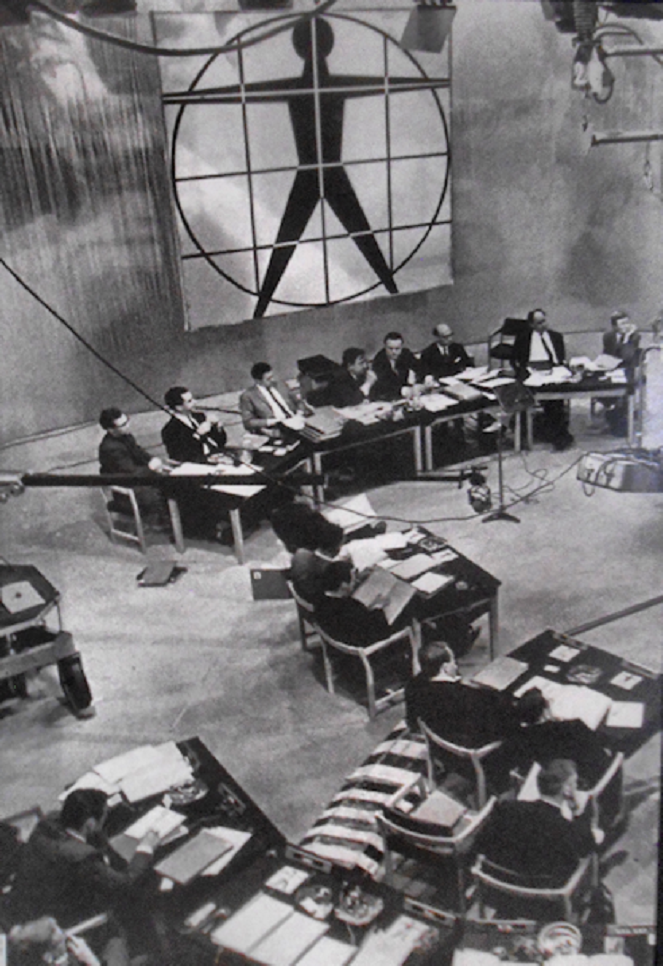
Bernie Newnham
I remember much discussion about who was at Abbey Road and what cameras (see “Our World”). I just saw this …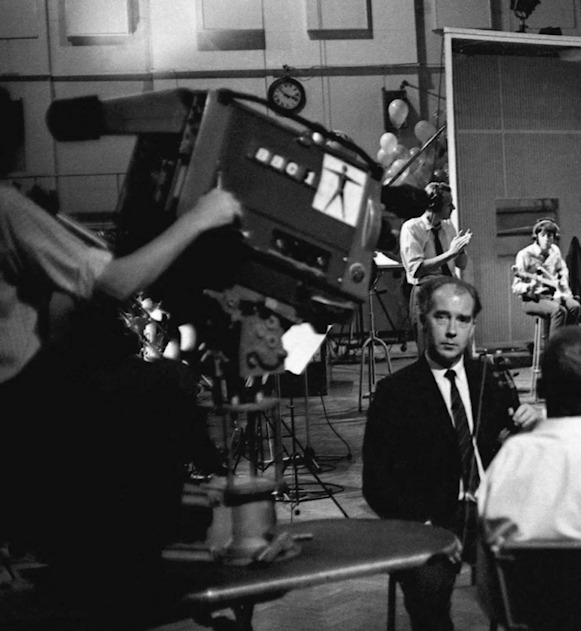
David Taylor
The photo shown above is by Leslie Bryce, taken on the Saturday afternoon rehearsals and that’s Dave Gautier’s camera on the Mole Crane. It has only ‘fixed lenses’ in the turret I see, even though Derek Burrell-Davis had requested all except the ‘control room’ camera to be fitted with V5 zooms.I now think it most probably stayed with fixed lenses, although I had thought it ‘zoomed in’ at the end of its ‘tracks’ each time. Perhaps a cameraman could review my composite video of the “All You Need Is Love” sequence and ‘advise me’…I’m only a soundman after all!
The other thought is that I rejected the idea that a minature Marconi V321 ‘pipe camera’ was in fact employed at all. The Director had requested one and in peering again at the video I think I’ve spotted it’s use at 4.52 in the timeline. A small camera is in the background of the shot and it looks like the little V321 to me. I also think the operator is wearing cans!
Any engineers or cameramen know anything about that strange early ( it’s 1967!) hand-held Vidicon camera?…It had no viewfinder!
Once again, my post about ‘All You Need Is Love’ is here.
And the video I compiled from the black and white and colourised sections is towards the end of my rather too detailed post!
Alan Taylor
I know that Kendal Avenue did have at least one Marconi drainpipe camera. When I joined in 1968, it was used as a general purpose fixed camera which could be mounted and simply cut to whenever it was needed. I don’t ever recall it being fitted or used with any viewfinder other than a standard portable monitor for checking framing and focus.The only time I can remember it being used on a show I was working on was in 1970 when it was used as a caption camera on a show which was otherwise in colour. I can’t remember why it was being used because units in those days had a large caption scanner rather like an oversized tea chest which travelled on the camera van. The proper caption scanner had a built- in vidicon camera, lighting and a mechanism to allow 12×9 captions to be changed in shot.
Nick Ware
I don’t remember the Marconi drainpipe Vidicon camera, but I’d be surprised if it was able to be synchronised to station (or whatever) syncs. The reason I say that is because around that time I had looked fairly thoroughly into Vidicon cameras just for the fun of it, and actually built one. The tube was an ex-Pres ‘A’ reject scrounged from Valve Maintenance on the 4th floor, which you could do if you could show that you had a yoke for it, and by chance, Elektor magazine (first published in 1960) had an advert for a vidicon tube yoke. The rest I had to design for myself. I already had a suitable Dallmeyer ‘C’ mount cine lens. My moment of huge pride was while on a Sound attachment to Pres A, an always jovial engineer, whose name I wish I could remember, routed it into the Continuity A mixer one afternoon with it set it up in front of the rotating World globe. I was dead chuffed, not just because its picture was up on air, but that the whole of BBC1 was synced to it!Chris Woolf
Indeed, Nick,The Marconi 321 drainpipe camera was either crystal or mains locked – nothing else.
The true broadcast cameras of that era all ran off ‘drives’ – line, field, mixed syncs, blanking etc.
The drainpipe counted as “industrial” and so looked after its own sync.
David Taylor
Thanks for the information that the little Vidicon ‘drain-pipe’ camera was in later use.At the time of the Abbey Road OB Burrell-Davis’s Programme requirements sheet asked for a “Marconi hand-held camera, on line and on cable. (Requested through Norman Taylor on 11th May 67)”.
The reply came back via Norman Taylor from the Asst. to Superintendent Engineer, Studios and OB’s concerning ‘the Marconi V321 Vidicon hand-held’ that “…We are, at present, awaiting a reply from Marconi as to whether this equipment will be available, but in the meantime you should discuss the use of this camera with the Engineering Manager concerned as there may well be staffing and lighting problems from its use…”. Two days later the memo had a hand written note attached that said “Hugh (the EM doing the lighting was Hugh Cartwright) sees no great problems”.
I thought I would have been able to tell, from the ‘wobbly shots’ if a hand-held was being used during ‘All You Need Is Love’ and had assumed it wasn’t put to use, but I do now think that it might be the hand-held camera seen passing in the back of that shot (4.52ish in the All You Need Is Love video I posted) that I mentioned in the earlier post.
What with using a Mole Crane on an OB and possibly this early use of a small camera, Burrell-Davis was being quite daring, I guess.
Small cameras began to appear later of course and at LWT we were using little LDK13 cameras occasionally a few years later on, as I know the BBC were, but the Marconi V321 didn’t have a proper viewfinder and must have relied on a small external video monitor to focus etc. and I don’t know what the phrase ‘on line and on cable’ that D B-D used might mean. Perhaps the CCU was displaced out of the scanner?
Alan Taylor
If anybody is still in touch with any BBC Tel OB vision engineers from that era, they might be able to explain.I can remember the drainpipe camera kicking about in Vision Test Room for a long time and often being messed about with, so presumably a lot of engineers must have worked on it at some time.
Peter Fox
[All of] which leads to the tale of when the whole network came to be effectively super locked (was that the right term?) to the little green EMI vidicon in studio E on Grandstand that just did odd captions. Job done, before “Off Air” Switched off….


